|
Late
14th Century & 15th Century Women's Gowns
THE ITALIAN KIRTLE - THE EUROPEAN LATE 14TH CENTURY
GOWN -
THE 'BURGUNDIAN' GOWN - OTHER MEDIEVAL GOWNS
There are a
few other variations of medieval dress which are outside my main
field of interest, so I'll include a very brief overview on what
they were and what they looked like. 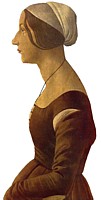 There
is a wealth of specific information on these types of medieval
dresses online for those who are particularly interested in those
time periods. There
is a wealth of specific information on these types of medieval
dresses online for those who are particularly interested in those
time periods.

The
Italian kirtle
This is the 15th century dress which has a separate bodice which
is cut at the natural waist line. Shown at left is a detail from
a 1475 painting by Botticelli, Portrait of a Young Woman.
It laces at the front and has separate sleeves which lace on.
This style is often referred to as a kirtle, but it is not the
same kind of kirtle which is written about in England and France
in the 13th and 14th centuries. This style was widely popular
in Italy and other parts of Europe, well before the waisted-style
of kirtle is seen in England.
Sleeves were often made of
a different material and could be quite rich or brocaded. It was
worn to the ground or just above and did not have a train. It
would always have been worn with an overgown in public.

Late
European 14th century gown
I'm not sure if this gown had a specific name, although I suspect
it was often referred to as a gown. 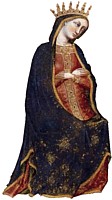 Although
predominantly seen in the late 14th century, this style of gown
can be seen throughout the medieval period in European artworks.
It appears in Spanish and Western European art and does not appear
to have been worn in England or France. Although
predominantly seen in the late 14th century, this style of gown
can be seen throughout the medieval period in European artworks.
It appears in Spanish and Western European art and does not appear
to have been worn in England or France.
This gown has the distinguishing feature of a wide elaborate embroidered
band at the wrists, neck and down the front of the gown. Often
the sleeves also has a strip of gold-thread embroidery down the
back of them.
Occasionally,
these appear buttoned to the elbow allowing the chemise to be
seen underneath. Often the sleeves are laces up to the elbow permitting
the chemise to show through. This style of sleeve continued to
develop well into the renaissance. It is shaped through the body.
The detail at left dated at 1381 is by Stefano di Sant Agnese
from the Coronation of the Virgin.

The
Burgundian Gown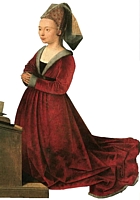
This seems to fall into two distinct styles- those which are cut
in one piece and those which are cut with a bodice. The detail
at right from 1450 by Petrus Christus Portrait of a Female
Donor .
To be honest, most paintings of the gown known as the Burgundian
gown look to me more like a version of the houppelande, only worn
a slightly different way. It still looks like a large, warm overgown
with the collar folded back even further than before and the cuffs
of the fur-lined sleeves turned back. 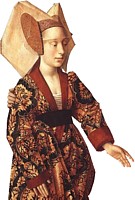
The front of the kirtle underneath is visible and it was extremely
fashionable to wear bIack or another dark colour underneath. The
wide belt was usually buckles at the back and draws the gown in
forming pleats under the bust and only a little over the breast.
The A line of the gown sometimes looks like the bottom part is
sewn on separately. I believe that the collar is not a separate
piece at this stage.
The detail from the 1449
painting by Christus of St Eligius in his Workshop, shows
a gown which does not have a separate bodice and is also drawn
in with a belt.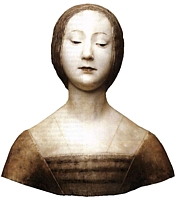

Other
medieval gowns
A little later in the 15th century, the gown abandoned
the collar and cuffs and the V opening at the front widened even
further. It was often worn with a transparent neckerchief which
was worn around the neck and tucked into the front of the underdress.
This style of gown can be seen at right in the sculpture from
1487-1488 by Laurana, Bust of a Lady. This style is also
sometimes referred to as the Burgundian gown and almost certainly
has a separate bodice which sits high under the breasts.

Copyright
© Rosalie Gilbert
All text & photographs within this site are the property of
Rosalie Gilbert unless stated.
Art & artifact images remain the property of the owner.
Images and text may not be copied and used without permission.
|